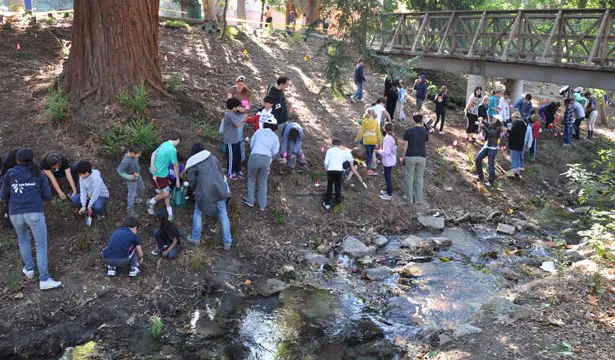The once mighty Stone Canyon Creek was formerly a dominant feature of the UCLA campus. over the years, as the campus expanded, the creek was routed underground and now only this small segment runs behind the Anderson School of Management. Restoration of the site began in 2008 with The Bay Foundation hosting community events to restore the watershed in collaboration with the Institute of Environment and Sustainability. The project evolved with integration of the Ecology and Evolutionary Biology Restoration Ecology course (EEB 136). From that class, a group of dedicated students established the Ecological Restoration Association (ERA) at UCLA. Volunteers coordinated by ERA continue to eliminate invasive vegetation, replant native vegetation, and restore ecosystem functions, with the support of Facilities Management and Sustainability. The newly established vegetation removes pollutants from the water and serves as habitat to birds and other wildlife on campus.
UCLA students, staff, and faculty have partnered with The Bay Foundation and thousands of volunteers over the years to restore the ecosystem of the only natural riparian habitat that still remains on campus. These efforts are currently led by Professor Alison Lipman and the student organization Ecological Restoration Association at UCLA. Serving as a “living laboratory”, this area teaches students practical skills and techniques to monitor and restore natural habitats.
Some of the species found at Stone Canyon Creek include:
Plants
Toyon
California rose
Coast live oak
Mugwort
Hummingbird sage
Yarrow
Blue eyed grass
Deer grass
Willow
Birds
American robin
Dark eyed junco
Allen’s hummingbird
Black phoebe
Yellow rumped warbler
Bushtit
House finch / sparrow
The Ecological Restoration Association at UCLA and Stone Canyon Creek volunteers acknowledge the Gabrielino/Tongva peoples as the traditional land caretakers of Tovaangar (the Los Angeles basin and So. Channel Islands). As a land grant institution, we pay our respects to the Honuukvetam (Ancestors), ‘Ahiihirom (Elders) and ‘Eyoohiinkem (our relatives/relations) past, present and emerging.
